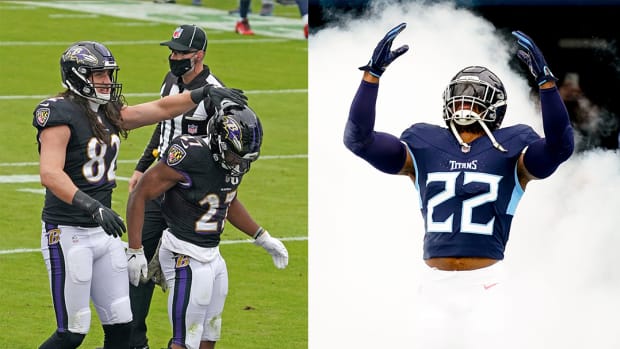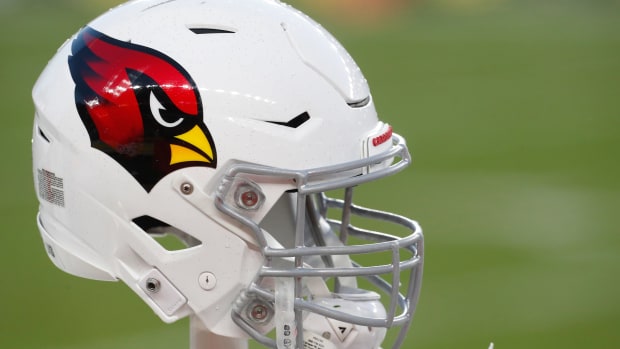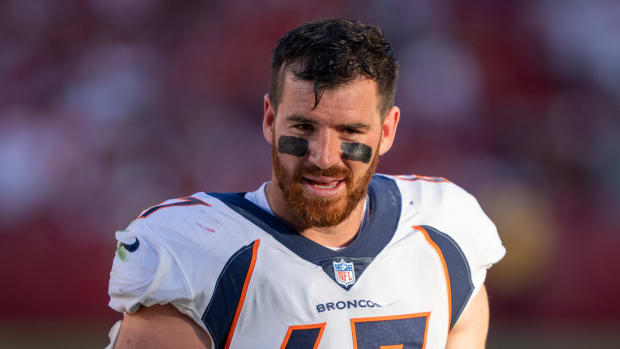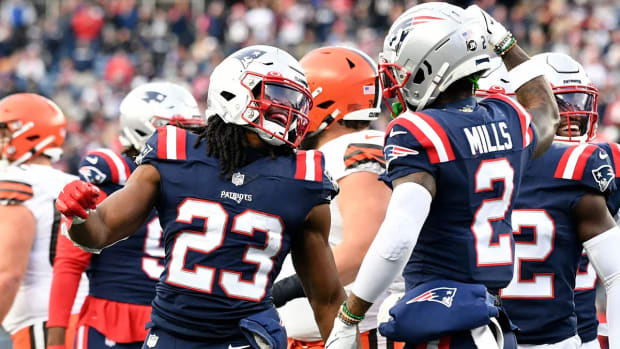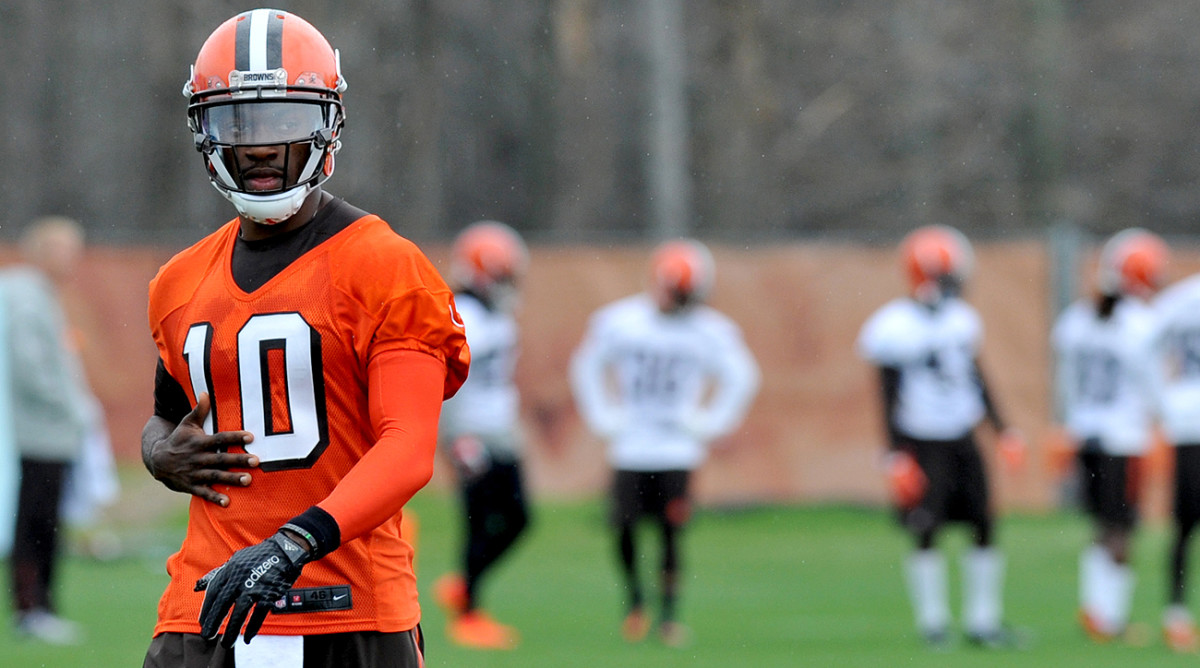
The Ongoing Growth of Griffin
To the outside world, it seemed that Robert Griffin arrived in Cleveland weighed down with four years of baggage from a most unusual run as franchise savior-turned-bust in D.C.
Good thing for the star-crossed quarterback, his new head coach never looked at it like that.
“I said this to all the players: Everybody’s slate is clean,” rookie Browns coach Hue Jackson said from his office earlier this week. “You always want to give guys the benefit of the doubt coming in, and I have not seen, heard or felt any negativity out of him. That’s the only Robert Griffin I know. He’s been an ideal teammate, a hard worker, he wants to please his coaches and he’s followed directions. That’s all I know.”
What Jackson doesn’t know yet (or if he does, he isn’t saying) is whether or not Griffin will be his starter for the team’s opener Sept. 11 in Philly. Veteran Josh McCown is another option, as is rookie Cody Kessler with Connor Shaw and Austin Davis filling out the depth chart.
But as minicamp wraps today, 11 weeks to the day that Griffin signed, it remains the likelihood that Griffin will be the guy. And while that doesn’t guarantee anything, and the 26-year-old doesn’t need to be reminded of that—he held the Washington starting job through the spring and most of summer last year before being unseated by Kirk Cousins—just holding serve signifies a step forward after a season in which he didn’t take a single snap.
In this first installment of my Inside the NFL notebook for The MMQB, we’ll look at the Von Miller-Broncos contract situation, Cardinals’ next small-school prodigy, the Jets’ never-ending QB saga, players to watch from this week’s minicamps, and the embattled Art Briles’ connection to pro football.
We’ll start in Cleveland, where Briles’ most high-profile prodigy is trying to recapture the magic he carried from Waco to Washington in 2012.
Two years ago, Washington coach Jay Gruden told me that, despite a spectacular debut season, Griffin was still painfully raw as a pro quarterback, emphasizing that it would take patience to see him through to the point at which his game would have NFL staying power. To be sure, Jackson has seen growth, but it’s also easy to see that he knows what Gruden was trying to say.
“I’m not gonna say he’s raw, but he is still developing. And most young quarterbacks are still developing,” Jackson said. “I’d give coach (Mike) Shanahan and his son a lot of credit—he came into the league and they fashioned an offense for him that worked for him. And I’d give him credit too, coming out of the Baylor system, without the traditional footwork you play with, he produced right away.
“Those guys were able to mesh together a great season, but all that is in his past. It’s about mastering the quarterback position now. Mastery of how to play the position is the key to his success.”

Hue Jackson is going to make his quarterbacks—Griffin and Josh McCown—earn the starting job.
Nick Cammett/Diamond Images/Getty Images
And that means learning the things Griffin wasn’t asked to do as a rookie, and the things he struggled with over the three years to follow.
That started nearly three months ago with Jackson directing Griffin to work with quarterbacking guru Tom House, someone Jackson called “one of the greater teachers in dealing with quarterbacks around.”
“If he’s not around me, I want him to be around the best,” Jackson said. When Griffin has been around Jackson, there’s been an emphasis on footwork, progression reading, and protecting himself and being smart on off-schedule plays. There, the coach says the improvement has been “twofold.” In fact, one most encouraging moment of the last couple weeks of work was Griffin hitting the deck on a lost play.
“There’s a time to say uncle,” Jackson said. “He’s taught himself to slide.”
The concept of a first-round reclamation project at QB isn’t a new one. There’s always hope in these situations. The reality is Jim Plunkett and Steve Young stories are few and far between.
Teams have cut ties with 15 first-round quarterbacks over the past 10 draft classes. Only two of those 15 have lasted more than two seasons with their second teams. One is Jay Cutler, whose ouster from Denver was driven by personality, rather than production. The other is Blaine Gabbert, who is entering his third season as a Niner.
So if Griffin makes this work, he will be an outlier.
But when I ran down the list to Hue, he responded, “I’m not sure any of those guys did it on that level that Robert did (in 2012). He did it. We know he can.” And taking that into account, I then asked if he believes Griffin can be the kind of franchise quarterback that a coach would feel comfortable tying his job security to.
“That’s yet to be determined,” Jackson responded. “Quarterbacks are made by wins. That’s how a guy has to do it consistently, then he becomes a franchise quarterback. We’re back in the first stages, trying to find a quarterback, then naming a quarterback, then letting him play, and over time we’ll see.”
That, of course, punctuates the underlying theme here, too. For all the improvement Griffin has made in shorts over the last couple months, he still has to win the job, and as was always the plan, Jackson will make him earn it.
“When it’s time to make [a decision], I’ll make it,” Jackson said. “I’m being honest. It’s still way soon. I know that’s what everyone’s worried about, but I’m not. There are no games yet. I think it’s a competition, so we can just let things play themselves out.
“We don’t feel any need to rush. When we name one we’ll feel good about, it’ll be because we put the guy through every test, and he passed.”
So maybe Griffin becomes a great story of perseverance in 2016. Maybe we see the magic of ’12 again.
For now? It’s June.
• ADS ON JERSEYS? Andrew Brandt weighs in on the next inevitable revenue stream
* * *

Contract talks have come to a standstill between Von Miller and the Broncos.
Doug Pensinger/Getty Images
FOUR DOWNS
1. Wild horses. Denver’s road to (try to) repeat hit two more bumps this week. And the most recent one involves the team’s best player. Yes, as ESPN’s Adam Schefter reported, Von Miller turned down a six-year, $114.5 million offer from Denver. But it wasn’t those numbers, per sources, that were the problem. The average per year, in fact, is one area where significant progress has been made. After the new league year started, Denver sat at about $18 million per (based off Justin Houston’s deal), while Miller’s camp was over $22 million per (based off Olivier Vernon’s new contract). The $19.08 million average is actually amenable to Miller’s camp, as is the cash flow. The problem now is the amount that’s guaranteed, which dictates how the long the team, as a practical matter, is tied to him. And yes, there was a deadline set for Monday night, but it’s not the first deadline that’s been set (there was another one in May) by the team, so it’s not as if the now-dormant talks can’t be revived. If things don’t get better, where does Miller turn? Well, here’s an interest twist to the story. If Miller is willing to sit out the season, per a union source, the Broncos can’t exclusive tag him again. They can put the non-exclusive tag on him, at the normal tag rate, but the comp for another team to sign him then drops from two first-round picks to a first and a third, which some team may well being willing to pay. Now, I’m not saying Miller would be willing to sit out the year. What I am saying is there is some motivation to do so tucked in the rules. As for the Aqib Talib saga, one point that should be made here—late in his Bucs career and through his time with the Patriots, Talib was seen as a good employee inside the building; all his issues, as those teams saw it, were in Dallas, near where he attended high school. And if you go back further than that, the presence of those issues were why the Cowboys would’ve been very reluctant to take him in the 2008 draft. We still don’t know for sure what happened on Sunday night, of course. What’s pretty clear is Talib didn’t do a good enough job of avoiding what’s got him in these situations in the past.
2. Jets in command in Fitzpatrick talks.Four months ago, New York put a three-year, $24 million offer—with $12 million in Year 1 and $16 million in guarantees—in front of Ryan Fitzpatrick, and bet he wouldn’t be able to beat the combination of their money and playing time. The Jets were right, which is why what they have on the table hasn’t changed. So when you hear that Fitzpatrick is willing to accept a one-year, $12 million deal, it’s a little like offering someone who’s taking you out to dinner the chance to pay for dessert and a nightcap too. That proposal is a 50 percent markup in average per year, and requires the Jets to cede extra years of control, and basically asks the team to bet against itself. So where’s the compromise? Well the sides have discussed lucrative incentives based on getting in the playoffs, and that could be the solution—maybe a one-year deal at the Jets’ number ($8 million) with those kinds of triggers that could take it to Fitz’s number ($12 million). Of course, the team’s patience won’t last forever. And while there is some feeling internally they could get by with Geno Smith, outsiders are skeptical. “I think they’ll struggle if [Geno is] the guy,” texted one rival defensive coach. “Too inconsistent, stares guys down, average at reading defenses, makes poor decisions. … Fitz is much smarter, more accurate, and a better leader.”
3. Cardinals keep mining small schools. When Steve Keim became the Cardinals GM in 2013, one advantage he had—as an internal hire—was knowledge of the team’s inner-workings. So he knew the structure of his predecessor, Rod Graves, and moved immediately to expand the scouting staff. Arizona went from two in the pro scouting department to four, and four area scouts on the college side to six. Today, Keim will tell you the wider net he’s cast is a big part of how they were able to identify guys like Justin Bethel (Presbyterian), John Brown (Pittsburg State), Rodney Gunter (Delaware State) and David Johnson (Northern Iowa). So here’s your name to watch from the 2016 draft class: Fifth-round safety Marqui Christian, who Arizona plucked out of Div. II Midwestern State. He has a rep as a big hitter and potential box safety, but my understanding is he’s already showing better range, feet and movement skills than advertised, and even some ability in man coverage. He’s not the physical presence that Deone Bucannon is, and he’s not as swift as Tyrann Mathieu, but Christian could well find a role quickly in James Bettcher’s system. Meanwhile, Johnson’s shown signs of making a big leap in his sophomore year, and Brown’s been right there with him as a top offseason guy in the desert. Add that up, and it’s pretty easy to see the value of the boots that Keim asked ownership to put on the ground a few years back.
4. Foles still on the block. You can probably characterize the situation between the Rams and Nick Foles as the most amicable holdout you’d ever see. Because the team is the only one of the 32 not to hold a mandatory minicamp, Foles technically doesn’t have to show up to anything until late July. And with Foles away, Los Angeles can get backups Case Keenum and Sean Mannion more reps (Jared Goff was gonna get plenty, regardless). So why are the Rams holding on to Foles? The belief internally was that his trade value would be at a low point between the draft and the start of training camp, and that was before a record 15 quarterbacks were selected at the end of April. Depth charts are stocked, and young guys need work. But once camp starts, and there’s an injury or two, or someone’s backup isn’t coming along as hoped? Foles could well be an intriguing option—he has 35 career starts, is just 27 years old, and is set to make just $1.75 million in an environment where quality backups are going for four times that. Say, for example, the Chiefs have an injury or their young developmental guys struggle. Would it be worth throwing a late-round pick LA’s way for Foles? It might be. It, of course, isn’t ideal for the Rams that they already gave Foles his $6 million roster bonus for 2016. But, as they see it, they money may well wind up buying them an extra pick for ’17.
* * *
THREE CHECKDOWNS
1. Sometimes, familiarity is important. So when the Ravens were looking at the prospect of taking Laremy Tunsil an hour after his gas-mask video went viral, the fact that John Harbaugh is close with Notre Dame offensive line coach Harry Hiestand certainly is worth noting in their selection of ex-Irish tackle Ronnie Stanley.
2. Hopes are as high as they’ve been since the Rich Gannon years in Oakland, and Derek Carr is a major reason why. And his presence this spring has been huge for a growing team. This, in fact, is his first full offseason as a pro—he missed five weeks last spring with a finger injury.
3. Name to watch as spring turns to summer: Bears wideout Kevin White. White missed all of his rookie year with shin injuries, but is healthy now. Jay Cutler has been working with White since winter, and has privately expressed how impressed he is with what White brings to the table physically.
* * *
TWO PLAYERS TO WATCH FROM THIS WEEK’S MINICAMPS
1. Eagles QB Sam Bradford. While Doug Pederson has gone to great lengths publicly to make clear that Bradford is the No. 1 in Philly, it’s clear inside the building that the veteran needs to earn the nod over Chase Daniel and Carson Wentz. That said, outside of Bradford’s brief holdout, it doesn’t seem like he’s done much to cast doubt on the idea he’ll win the job. And opponents did see a different guy in December last year, as Bradford gained his footing in Chip Kelly’s system and got more comfortable on his surgically repaired knee. Now, he just has to prove he can withstand another scheme change. “He definitely got better and more comfortable in the system as (2015) went on,” said one rival defensive coordinator. “I think there’s a huge difference in him from September compared to December. But now, he’s involved in the system change and there’s all the bitterness of his offseason. He’s definitely got an elite skill set still. He was the first pick in the draft, for crying out loud. But a quarterback has to understand the nuances of the system, he has to feel totally comfortable, and this is the fifth system on his career.”
2. 49ers QB Blaine Gabbert. Count me among those who don’t buy the notion that Gabbert isn’t a good fit for Chip Kelly’s system. Others outside San Francisco agree. “You saw what Nick Foles did with Chip—he was tremendous,” said one NFC exec. “If you look at Blaine last year with a limited cast—a very limited cast—you see he’s a better QB than Foles. He just got thrown to the wolves early on and it was easy to call him a bust. It was easy to say that he can’t play. But he’s matured, he’s clearly gained the confidence of the locker room there. … And he has all the tools you want for Chip. He moves well, runs well, he’s smart, has a big arm. I mean, everything chip wants in a QB is there with Blaine.” Now, as I mentioned earlier, these QB reclamations rarely work. But this one should at least be interesting enough to warrant your attention.
* * *
EXTRA POINT
A few years back, Art Briles was on an early list of about 25 candidates for an NFL coaching job. The team, as I understand it, was looking for a coach who would be a CEO type. Based on this club’s research into Baylor, Briles didn’t fit the bill in that regard, and so he was eliminated when they cut the list down to 10.
But before they could, and independent of that interest, the team got feelers that Briles would certainly listen if asked. Additionally, the Baylor coach wasn’t shy about telling NFL types who rolled through Waco that he’d eventually want to give the pros a shot.
After the events of the past few weeks, the ship has sailed on Briles being an NFL head coach any time soon, if ever. But could his next step be a lesser role with a pro club, like the one Chris Ault held in Kansas City or Jim Tressel held in Indy?
While I’m not sure it would be likely, I do believe a lot of teams would be able to use him. One coach said that it’d make sense to have him help a defensive staff, in teaching them to get inside the head of an offensive coach running the spread. A few other people agreed that he could help a team looking to tweak its offense.
“The big-picture stuff, he’s good at,” said one AFC scout. “The detail is why his offense would fail in the NFL. His offense at Baylor is not detailed—we’re gonna play tempo, we’re gonna play fast, and we’ll get you with our speed and just out-athlete you because our guys don’t have to think and your guys do.”
Now, of course, the big question is this one: Would an NFL club be able to do it, given the current climate in the league relating to violence against women? That’s where one NFC exec shot the idea down out of hand to me, saying, “The league would raise hell.”
The exec pointed out that Tressel’s NCAA transgressions didn’t even have an application to NFL life, as is the case with many college scandals. And he added that you could argue that as bad as Bobby Petrino looked, the damage he did was to himself and his family, and not a larger community.
Briles’ situation is different. And my guess is this NFC exec is dead on with his assessment.
In the end, I can’t see it being worth all the negative attention to get another set of eyes—football brilliant as they might be—on a team.
• Question or comment? Email us at talkback@themmqb.com.
































